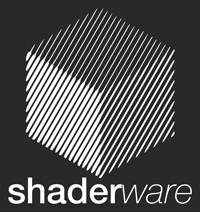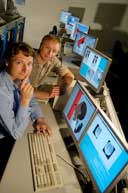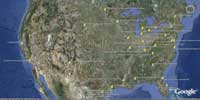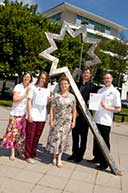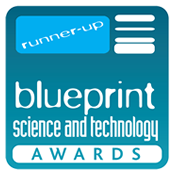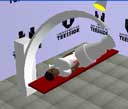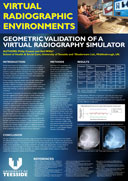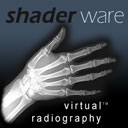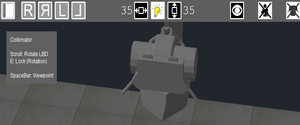
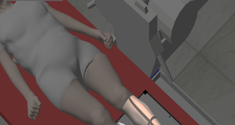
Shaderware
Shaderware is the leading provider of virtual reality training systems in diagnostic radiography and is located in North East England. The system is branded virtual radiography TM. The brand aims to become synonymous with innovation, excellence, technical brilliance, academic rigour and exceptional design.
Our simulations are used worldwide. There are currently hundreds of licences at well over 100 customer sites worldwide, and our installed base has expanded rapidly since the company was formed in 2006.
View shaderware customers in a larger map
Shaderware Limited is a company registered in England and Wales with Company No: 05897159.Date of Incorporation: 4 August 2006.Registered Office: 62 West Crescent, Darlington, Co. Durham, DL3 7PRVAT Reg No: GB-825 5772 08
News and Events
Hardware compatibility Issue
6th April 2023
We have become aware that Intel has removed native support for DirectX9 in the 12th and subsequent generation of embedded graphics chips. Although they offer an emulation layer some features our system relies upon are currently non-operational.
It is possible that Intel or Microsoft may release new drivers which fix this incompatibility in the future, but this is the current situation. Please see the intel product support page:https://www.intel.com/content/www/us/en/support/articles/000091238/graphics.html
We recommend retaining your existing hardware and not upgrading to 12th-generation and later intel-embedded graphics. If you are forced to upgrade, you should purchase discrete graphics cards from NVIDIA or AMD, having tested all functionality prior to committing to purchase.
In conclusion, your current virtualradiographyTM simulation software and hardware pairing will continue to provide excellent service. However, any future hardware upgrade instigated by you needs to be carefully chosen to preserve this functionality.
TomoVR TM V1.0 Flies of the shelf
20th October 2017
Shaderware announce the first customer orders for TomoVR TMThis is the fastest uptake of any of our products to date and we are pleased to see that it is a repeat purchase from one of our established customers, the University of the West of England.
TomoVR TM V1.0 Launched
23rd September 2017
Shaderware launched the worlds most advanced Computed Tomography Educational Simulator. After early demonstrations at the European Congress of Radiology in Vienna the background work to ensure a robust and reliable product can be made availabe have been completed. Our beta test institutions in the UK and Australia have given the final product a clean bill of health, after suggesting a few refinements. The licence server has been updated to ensure trouble free floating licences. Contact us for pricing and demonstrations.
TomoVR TM V1.0 Demonstrated
1st March 2017
Shaderware will be Demonstrating the worlds most advanced Computed Tomography Educational Simulator at this year's gathering of Radiology in Vienna, Austria #ECR2017 - This brings their VirtualRadiography TM family of radiography simulators up to date. New benefits include:
driven by a Modality Worklist populated with dozens of patient case histories
dual localizers generated to enhance scan planing
scan planing includes start point, stop point, scan direction, field of view and iso-centre identification. All these parameters influence the resultant images acquired
realistic 'plan, load, move, execute' workflow
scans produced from proprietary highly detailed whole body data-sets, all of the same specification
data is registered with the patient avatar, leading to valid isocentre and set up positions
image data displayed with vaiable windows and DFoV
technical output, includes CTDI, DLP to ensure optimization is considered as part of training.
image appraisal workflow is possible due to annotated display with patient demographics and scan parameters
TechnicVR TM V2.0 Released
1st March 2016
Shaderware will be launching TechnicVR TM version 2.0 to coincide with this year's gathering of Radiology in Vienna, Austria #ECR2016 - This brings their VirtualRadiography TM family of radiography simulators up to date. New benefits include:
Modeling Computed Tomography exposuresNew 'Spectroscope' visualisationSupport for more screen display formats.
Virtual Radiography TM Webinar Programme
During 2015 we will be delivering a series of free-to-attend webinars for both existing customers looking to up-grade to the latest release or prospective customers interested in evaluating Virtual Radiography TM
These web based sessions provide a perfect opportunity to find out more about the Virtual Radiography TM suite of simulators. They are intended to allow discussion of the potential for your individual training programme. The session provides a general overview of all three components of Virtual Radiography TM and their recent developments. Sessions are interactive; there is ample opportunity to ask questions. The session lasts up to one hour.
View the Webinar Programme.
ProjectionVR TM V5.1 Released
20th April 2015
ProjectionVR TM v5.1, the tenth significant release of our flagship product, became available free to qualifying customers from midnight GMT on the 20th April, 2015. This update introduced 'phantom lab' - enabling upper limb virtual radiography[TM] for the first time. Other significant enhancements include easier windowing controls, demographic annotation, and a whole new room appearance.
View the introductory video.
ProjectionVR TM V5.0 to be first shown at 18th ISRRT World Congress Helsinki 12-15 June 2014
24th February 2014
Shaderware Limited are delighted to announce the launch of their new radiography simulator, ProjectionVR TM v5.0. The launch will take place on 4th March 2014, with an online 'launch party' being hosted for all existing customers and others interested in the system.
ProjectionVR TM is already established as a key learning resource in over 80 colleges in fifteen countries. The UK based Society of Radiographers are convinced that it allows students to work in an environment that safely simulates the conditions of an X-Ray unit. The underlying technology has been demostrated to produce valid radiographs and accelerate radiographic skills learning.
Students benefit by increasing the 'time on task' possible in radiography education. Students often would prefer more time in live x-ray rooms during their training. This is difficult to achieve due to limited resource and supervising staff availability. With ProjectionVR TM students have their own x-ray room within a laptop or lab based computer. They can therefore practice at their own convenience and during supervised sessions.
The new upgrades build on the previous releases, and are the most significant advances in functionality since the launch of the simulation.
There are now male and female patients, and these patients can be posed more easily to achieve more projections. The existing database of examinations has been linked with a Modality Work-list. The work-list selects and displays hospital visits, made up of patients with specific clinical histories and indications for imaging. CR and DR receptors are selectable and have differing properties. The image is now presented as a digital image, not film. This allows windowing and the reporting of exposure index. Too much and too little irradiation now produces image 'burn out' or statistical noise. These effects have been validated against real digital systems. Scattering of x-ray photons in the patient is now modelled. The effect of scatter on the image is dependent on collimation area, tissue thickness, and receptor placement. Three different types of scatter rejection grids are available and 'clean up' the image more or less, depending on their design features.There are a significant number of other enhancements including a refresh of the user interface, new learning outcome driven lesson plans, calculation of a range of manufacturer specific exposure indices, and addition of QA objects such as an aluminium step wedge and Perspex slab. A webinar program of demonstrations via the internet is ongoing. Check the dates and times here ... Webinar Programme. Live demonstrations of ProjectionVR TM v5.0 will be available at 18th ISRRT World Congress Helsinki 12-15.6.2014. After the conference, Shaderware will be consulting with existing customers to offer upgrades at a very advantageous rate.
Controlled Trial of Virtual Radiography TM - White Paper Released
21st November 2012
Does time spent with a computer simulator actually transfer to better performance in a real world task? We would like to think so, and several authors have provided positive evidence. Indeed, the Chief Medical Officer of the UK, Sir Liam Donadson is so convinced he is calling for simulation to be urgently adopted as a mainstream teaching tool in healthcare education.
There is anecdotal evidence to suggest students are gaining real world advantages from time spent using virtual radiography TM. To investigate this scientifically, Teesside University have conducted a Controlled Trial. Read the white paper.
Student radiographer perspectives on using a screen based computer simulator in diagnostic radiography - White Paper Released
21st November 2012
The study set out to collect and explore student feedback from their time using either a screen based computer simulated diagnostic radiography environment (ProjectionVR TM) or participating in physical simulation group-work in a real x-ray room. The aim was to identify their perspective with the hope of validating and improving both experiences.
Read the white paper.
ProjectionVR TM V4.2 Released
1st February 2012
ProjectionVR TM v4.2, the eighth significant release of our flagship product, became available free to qualifying customers from midnight GMT on the 31st January, 2012. This update introduced virtual extremity radiography for the first time. New to the simulation is the ability to model both CR and DR systems. Other significant enhancements include calculation of entrance surface dose and an 'exposure index'.
Request an evaluation or find out about current pricing.
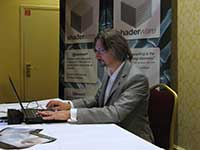
ProjectionVR TM V4.0 Launch Reported in Rad Magazine
September 2010
ProjectionVR TM v4 was released at the Association of Educators in Radiologic Science (AEIRS) annual conference, Las Vegas, Nevada, USA. The launch was reported in the September issue of RAD Magazine, Read the full article here
ProjectionVR TM V4.0 to be Announced at AEIRS
3rd July 2010
Shaderware Limited are delighted to announce the launch of their new radiography simulator, ProjectionVR TM v4.0. The launch will take place on 8th July 2010, at the Association of Educators in Radiologic Science (AEIRS) annual conference, Las Vegas, Nevada, USA.
ProjectionVR TM is already established as a key learning resource in over 50 colleges in five countries. The UK based Society of Radiographers are convinced that it allows students to work in an environment that safely simulates the conditions of an X-Ray unit.
Students benefit by increasing the 'time on task' possible in radiography education. Students often would prefer more time in live x-ray rooms during their training, this is difficult to achieve due to limited resource and supervising staff availability. With ProjectionVR TM students have their own x-ray room within a laptop or lab based computer. They can therefore practice at their own convenience and during supervised sessions.
The new upgrades to be released at AEIRS are the most significant advances in functionality since 2006. Sidemarkers can now be applied, to all receptors. All images are saved as DICOM objects to enable full integration with a PACS system or simple DICOM viewers. An extensive examination and projection database has been developed based on SNOMED CT standard codes; there are over 300 unique projections present. The x-ray machine operators control panel or console is faithfully modelled with exposure factor manipulation and audible simulation of exposure and grids are now selectable out of bucky.
Live demonstrations of ProjectionVR TM v4.0 will be available at AEIRS on stand 12, July 8-10th, 2010. After the conference, Shaderware will be consulting with existing customers to offer upgrades at a very advantageous rate.
Controlled Trial of Virtual Radiography TM Launched
5th November 2009
Does time spent with a computer simulator actually transfer to better performance in a real world task? We would like to think so, and several authors have provided positive evidence. Indeed, the Chief Medical Officer of the UK, Sir Liam Donadson is so convinced he is calling for simulation to be urgently adopted as a mainstream teaching tool in healthcare education.
There is anecdotal evidence to suggest students are gaining real world advantages from time spent using virtual radiography TM. To investigate this scientifically, the University of Teesside have launched a Controlled Trial, you can look at the protocol at http://www.controlled-trials.com/ISRCTN81149048/radiography . It is due to report findings late in 2010.
LectureVR TM 2.1 Update available!
10th October 2009
LectureVR TM v2.2.1 has been released to address issues with ATI Radeon HD2400 based graphics. Get the update if you use this hardware.
500th licence shipped
1st October 2009
Shaderware has shipped the 500th licence of it's remarkably successful virtual radiography TM simulator. This brings the total number of universities worldwide adopting the virtual radiography TM simulator to 38. Check out the current map of customers in the USA..
Virtual Radiography TM features in Award Winning Essays
27th June 2009
John Little and Hayley Powell came first and second respectively in the Higher Education Aacdemy (HEA) 2009 national essay competition.
The essays title was "What is your experience of using technology as part of your learning process? Please explain both the benefits and any pitfalls you have encountered". The competition was open to all students studying heath related courses in UK universities. The students wrote about their experiences using virtual radiography TM as an example of good, innovative use of technology they are experiencing in their course. For two students from the same university, let alone the same department, to be placed in this long running competition is unprecedented and quite a coup for the medical imaging department of Teesside University where both are enrolled in the first year.
Pictured: Mrs Susan Nixon (Principal Lecturer/Subject Group Leader, Medical Imaging) Miss Hayley Powell, Dr Margaret Sills (Academic Director of the Higher Education Academy Health Sciences and Practice Subject Centre), Mr Philip Cosson (Senior Lecturer, Medical Imaging, Virtual radiography project leader), Mr John Little

ProjectionVR TM V3.3 Beta Available
25th May 2009
In a change from our normal routine, we are releasing a beta version of our next upgrade to ProjectionVR TM. The new version will represent a radical improvement to controlling input. We have replaced keystrokes with mouse clicks, in a much more intuitive user interface. We have introduced context sensitive help, displayed onscreen to guide the student while learning. Of course, we have also taken the opportunity to tidy up other features in response to user feedback and testing. Send your feedback to feedback@shaderware.com; you can download the package from our download page. We will be running the beta alongside all our other virtual radiography TM simulations on stand 216 at UKRC, Manchester, 8-10th June 2009.

New Body Models for ProjectionVR TM
12th February 2009
Today marks a very important day in the development of virtual radiography TM products. We have been working for several years on delivering a validated skin surface model for our visible human data and version 3.2 implements models we are sure will reach this standard. The ability to conduct lateral projections is delivered for both the table and erect bucky modules. These now join the skull module becoming the most accurate diagnostic radiography positioning simulations in the world. The supine and erect module updates are provided as a free download to all existing supine and erect module customers respectively.
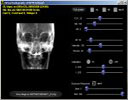
LectureVR TM 2.1 Released!
12th February 2009
Today Shaderware has announced LectureVR 2.1 This is a functionality update which allows simulation of cassette angulation against the central ray and the resultant distortion. Together with the recent addition of a variety of body models, this becomes a very powerful learning tool for radiographic positioning and anatomy.

LectureVR TM 2.0 Launched!
22nd December 2008
We have revamped the lecturer demonstrator tool. It has an enhanced interface and added body coverage (Knee, Pelvis, L. Spine, Thorax, Shoulder, C. Spine) to compliment the original Skull data. It will be down-loadable from the site as a stand alone installer. All license holders of the lecturer demonstrator module will be given the opportunity to upgrade FREE OF CHARGE - just contact info@shaderware.com.

New Body Models
22nd September 2008
Work has started on our new body model. This will be incorporated into virtual radiography TM 3.1 as a no cost upgrade for all current customers and should be ready to roll out early 2009.
2007 BLUEPRINT AWARD WINNERS
17th October 2008
Shaderware pick up two prizes at the regional blueprint finals. We were runners up in both the Science & Technology and the Creativity and Design Categories.
Learning Technologist of the Year 2007
22nd September 2008
Philip Cosson was awarded the 2007 Learning Technologist of the Year by The Association for Learning Technology. The Award was to celebrate and reward excellent practice and outstanding achievement in the learning technology field for his work on Virtual Radiograpy TM and his use of this technology in the classroom. Read more...
Prototype Cardiac Angiography Simulation Demonstrated
17th November 2007
A presentation of our prototype cardiac angiography simulation was well received by the Cardiac Radiographers Advisory Group (CRAG) study day on 17th November 2007 at Glenfield Hospital, Leicester. The delegates were the first to see the new software and were enthusiastic about the quality of the fluoroscopic image, simulation of 'flare', collimation, and the realistic controls of the C-Arm. Ideas for future enhancements were shared and further work will be ongoing.
If you would like to hear more, Contact Us.
UKRC 2007
22nd June 2007
Philip Cosson attends UKRC with a scientific poster entitled Geometric validation of a virtual radiography simulator.
Eastern Regional Society of Radiographers given a preview of virtual radiography v3.1
22nd January 2007
About 30 Radiographers from the Eastern Regional Society of Radiographers were given a sneak preview of virtual radiography 3.1 by Philip Cosson as part of their winter study day. The meeting at Peterborough General Hospital, attracted a lot of positive comment about some of the new enhancements planned. The most striking new feature is the ability for the students to forget the cassette!
In the Press
Accessed 08/07/2006]
Accessed 10/07/2006]

